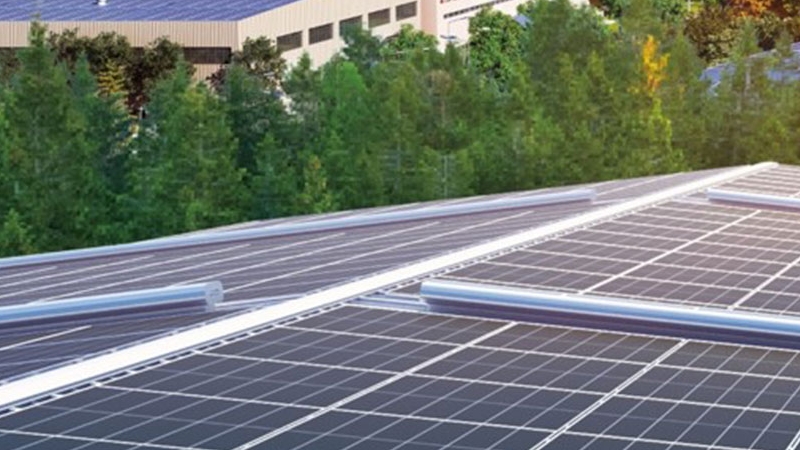从屋顶到空地,分布式光伏的 “灵活发电秀”
分布式光伏发电作为一种贴近用户侧的能源利用形式,正逐渐融入城市与乡村的能源体系。它依托分散的太阳能资源,通过在建筑物屋顶、空地等场所布设光伏组件,实现电能的就地生产与消纳,其特点既体现在能源利用的革新上,也反映在对传统电力系统的补充与优化中。
Distributed photovoltaic power generation, as a form of energy utilization that is close to the user side, is gradually integrating into the energy systems of cities and rural areas. It relies on dispersed solar energy resources and achieves on-site production and consumption of electricity by deploying photovoltaic modules on building roofs, open spaces, and other places. Its characteristics are reflected not only in the innovation of energy utilization, but also in the supplementation and optimization of traditional power systems.
能源利用的清洁性是分布式光伏发电最显著的特点之一。整个发电过程无需燃烧燃料,仅通过光伏组件将太阳光能直接转化为电能,不会产生二氧化碳、二氧化硫等污染物,也不存在废水、废渣的排放。这与传统火力发电相比,从源头上减少了对环境的影响,尤其在注重生态保护的区域,能有效降低当地的碳排放压力,助力绿色发展目标的实现。同时,太阳能作为可再生能源,取之不尽且分布广泛,避免了对煤炭、石油等有限资源的依赖,为能源结构转型提供了可持续的路径。
The cleanliness of energy utilization is one of the most significant characteristics of distributed photovoltaic power generation. The entire power generation process does not require the combustion of fuel, and only converts solar energy directly into electrical energy through photovoltaic modules. It does not produce pollutants such as carbon dioxide and sulfur dioxide, and there is no discharge of wastewater or waste residue. Compared with traditional thermal power generation, this reduces the impact on the environment from the source, especially in areas that focus on ecological protection, which can effectively reduce local carbon emission pressure and help achieve green development goals. Meanwhile, as a renewable energy source, solar energy is inexhaustible and widely distributed, avoiding dependence on limited resources such as coal and oil, and providing a sustainable path for energy structure transformation.
发电与用电的就近性极大提升了能源利用效率。分布式光伏系统通常安装在用电负荷附近,如工厂厂房顶部、居民屋顶等,所发电力优先满足本地用户需求,减少了电能通过远距离输电线路传输时的损耗。传统集中式发电需要庞大的输电网络将电力从发电站输送到各地,过程中约有 5%-10% 的电能因线路电阻等因素损失,而分布式发电通过 “就地生产、就地消费” 的模式,将这部分损耗降至最低,间接提高了能源的整体利用效率。对于用电负荷稳定的企业来说,这种模式还能降低对电网电力的依赖,减少电费支出。
The proximity of power generation and consumption greatly improves energy utilization efficiency. Distributed photovoltaic systems are usually installed near electrical loads, such as factory roofs, residential rooftops, etc. The generated electricity prioritizes meeting the needs of local users, reducing losses when electricity is transmitted through long-distance transmission lines. Traditional centralized power generation requires a large transmission network to transport electricity from power plants to various places, and about 5% -10% of the electricity is lost due to factors such as line resistance during the process. Distributed power generation, on the other hand, minimizes this loss through the "on-site production and consumption" model, indirectly improving the overall energy utilization efficiency. For enterprises with stable electricity loads, this model can also reduce their dependence on grid electricity and lower their electricity bills.

安装的灵活性与适应性较强是分布式光伏的另一大优势。其组件可根据场地条件灵活布置,无论是平面屋顶、倾斜面还是闲置空地,都能找到合适的安装方式。系统规模可大可小,小到几千瓦的家庭光伏板,大到几十兆瓦的工商业光伏电站,能根据实际用电需求和场地面积进行定制。这种灵活性使其不仅适用于城市中的工商业建筑,也能在农村地区推广应用,例如在农业大棚顶部安装光伏组件,实现 “农光互补”,既不影响农作物种植,又能产生电能,提高土地的综合利用效益。此外,分布式光伏系统的建设周期相对较短,从组件安装到并网发电通常只需数周时间,能快速形成发电能力。
The flexibility and adaptability of installation are another major advantage of distributed photovoltaics. Its components can be flexibly arranged according to the site conditions, and suitable installation methods can be found for flat roofs, sloping surfaces, or idle spaces. The system scale can be large or small, ranging from a few kilowatts of household photovoltaic panels to several tens of megawatts of industrial and commercial photovoltaic power stations, and can be customized according to actual electricity demand and site area. This flexibility makes it not only suitable for industrial and commercial buildings in cities, but also for promotion and application in rural areas, such as installing photovoltaic modules on the top of agricultural greenhouses to achieve "agricultural photovoltaic complementarity", which not only does not affect crop planting, but also generates electricity and improves the comprehensive utilization efficiency of land. In addition, the construction period of distributed photovoltaic systems is relatively short, and it usually only takes a few weeks from component installation to grid connected power generation, which can quickly form power generation capacity.
不过,分布式光伏发电也受自然条件影响较明显,发电量会随日照强度、天气状况和季节变化而波动,存在一定的不稳定性。这就需要通过与电网协调、配置储能设备等方式进行调节,以保障电力输出的平稳性。
However, distributed photovoltaic power generation is also significantly affected by natural conditions, and the power generation will fluctuate with the intensity of sunlight, weather conditions, and seasonal changes, resulting in a certain degree of instability. This requires adjustment through coordination with the power grid and configuration of energy storage devices to ensure the stability of power output.
本文由分布式光伏发电情奉献.更多有关的知识请点击:http://www.zdnygf.com我们将会对您提出的疑问进行详细的解答,欢迎您登录网站留言.
This article is a friendly contribution from distributed photovoltaic power generation For more information, please click: http://www.zdnygf.com We will provide detailed answers to your questions. You are welcome to log in to our website and leave a message
新闻推荐
product recommendation联系方式
Contact Information

 TEL:0531-82390078
TEL:0531-82390078 TEL:18805312017
TEL:18805312017 MAI:sdzdny001@163.com
MAI:sdzdny001@163.com 公司地址: 济南市历下区山大路157号
公司地址: 济南市历下区山大路157号 天合蓝天·山东种电
天合蓝天·山东种电 备案号:鲁ICP备17052940号-2
鲁公网安备37010202700164号
备案号:鲁ICP备17052940号-2
鲁公网安备37010202700164号
 网站地图|XML|TXT
网站地图|XML|TXT

扫一扫方便咨询我们

截屏,微信识别二维码
微信号:18805312017